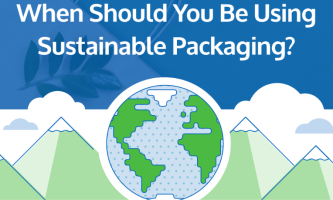
Preserve More, Waste Less: How Thoughtful Packaging Helps Protect Your Food, Your Health, and the Environment
Week after week, households toss out food that spoiled before anyone had the chance to enjoy it — soft berries, limp greens, leftovers that didn’t last. While it may seem like a small frustration, the consequences of food waste extend far beyond an unpleasant smell or a few lost servings. Spoilage affects your finances, your health, and the planet. The good news? A major part of the solution starts with the packaging choices we make. For families focused on sustainability and healthier living, understanding why food breaks down so quickly — and how thoughtful packaging helps slow that process — is essential. The True Cost of Spoiled Food Food that doesn’t get eaten comes with a much larger price tag than most people realize. Globally, wasted food accounts for more than $1 trillion each year, with a significant portion originating in private homes. For individual households, this can amount to hundreds or thousands of dollars in unnecessary grocery expenses. Beyond personal budgets, wasted food drains natural resources. Enormous amounts of land, fuel, and water go into growing and transporting food that ends up in the trash. Nearly one-third of the world’s freshwater supply is used to produce food that ultimately spoils. Once discarded, decomposing food releases methane — a greenhouse gas far more potent than carbon dioxide — contributing significantly to climate change. Reducing spoilage is one of the most impactful steps homeowners can take to lower their environmental footprint. Why Food Goes Bad Before You Expect It Two major factors accelerate spoilage: contamination and excess moisture. Contamination can occur easily in everyday kitchen routines. Harmful bacteria spread quickly when raw and ready-to-eat foods are stored too closely together or when hands, utensils, and surfaces aren’t cleaned thoroughly. Food stored in poorly sealed packaging or left out longer than intended only hastens this decline. Moisture poses another challenge. Refrigerators naturally create humid environments, and without proper airflow or protective packaging, mold and bacteria thrive. Produce and leftovers stored in thin, weak, or non-ventilated containers break down much faster. How Better Packaging Keeps Food Fresher Fortunately, sustainable packaging innovation has evolved significantly. Modern packaging — such as moisture-resistant, vented polypropylene corrugated containers from companies like SeaCa — is designed to maintain freshness by improving airflow, reducing humidity exposure, and providing stronger protection during storage. Choosing smart packaging options, whether at the supermarket or in your own pantry, can drastically slow spoilage. Durable, reusable, or recyclable containers also reduce reliance on disposable plastics, supporting both freshness and sustainability efforts. Food Spoilage Isn’t Just Waste — It’s a Health Risk Once food begins to spoil, it becomes a breeding ground for dangerous bacteria. Foodborne illnesses can range from mild discomfort to severe, costly health complications. In the United States alone, millions of people get sick every year from contaminated or spoiled foods, with vulnerable groups like children, pregnant women, and older adults facing the greatest risk. Quality packaging acts as an extra barrier, helping protect your family from harmful pathogens. Simple Ways to Reduce Spoilage at Home Small adjustments can make a big difference: • Choose produce packaged in breathable, protective materials• Use high-quality, reusable containers designed to control moisture• Store items in low-humidity zones or use liners that absorb excess moisture• Keep hands, surfaces, and storage areas clean• Buy realistically and portion food to avoid forgotten leftovers A More Sustainable Kitchen Starts With Smarter Packaging Cutting down on food waste doesn’t require a complete lifestyle overhaul. By choosing better packaging and adopting mindful storage habits, households can save money, reduce environmental impact, and keep food safer for longer. Every decision you make in your kitchen contributes to a healthier home and a healthier planet. With more intentional packaging choices and careful storage practices, you can preserve more, waste less, and build a more sustainable future one meal at a time. Read Also: Boxed Packaged Goods: The Right Guide To Uplift Your Business
What’s Happening

Strengthening Corporate Sustainability Through Smarter ESG Reporting
Nov 21, 2025

The AI Revolution: How Industries Are Driving Innovation?
Nov 20, 2025

The Overlooked Bottleneck: Why the First 100 Feet Deserve More Attention
Nov 19, 2025

A&TA: Why Is It Important for Your Business Growth and Performance?
Nov 19, 2025

Branding Blind Spots: The Hidden Gaps That Undermine Clarity
Oct 24, 2025

Beyond the Bin: How Food Waste Impacts Business Profitability
Oct 24, 2025
Top Story
The Benefits Of Migrating From Monolithic To Composable Ecommerce
Feb 16, 2023

The Rise Of Mephedrone Synthesis: Unveiling The Health, Business, And Food Implications
Sep 20, 2023

EUA Share Price Forecast: Everything You Should Know
Feb 22, 2022

Major 5 Differences Between Mass-Market Paperback Vs. Trade Paperback
Aug 02, 2021

MNPR Monopar Therapeutics Inc. Stock Forecast And News
Dec 06, 2021

Top 9 Successful Serial Entrepreneur Of All Time – 2022 Updates
Nov 12, 2021


Closing the Gaps: How B2B Enterprises Can Stop Revenue Leakage
Oct 23, 2025

Cybersecurity for Customer Platforms: Raising the Bar on Protection
Oct 22, 2025

Driver Health: The Hidden Gear Behind Fleet Safety
Oct 22, 2025

Rethinking Packaging: The Growing Importance of Sustainable Solutions
Oct 21, 2025
Small Business

Tribological Properties Of Tungsten Disulfide (WS2)
In machines, there are mechanical parts that move in relative motion to each other, and there are contacts between them. This causes the parts to run against each other, which leads to friction and wear. This affects the machines' energy efficiency and mechanical endurance. Repeated and uncontrolled friction can lead to wear and tear, damaging the parts. We can use lubricants to overcome this. There are different types of lubricants, such as solid/dry, liquid, semi-solid, and gaseous. One of the solid lubricants is Tungsten disulfide (WS2). WS2 exhibits excellent tribological properties due to its layered structure. A layer of W atoms is located between two layers of the S atoms. Within the layer, the atoms have strong covalent bonds, while the adjacent layers interact with weak Van der Waals forces. This leads to an easy interlayer shear of the structure and gives WS2 excellent lubricating properties. Tribology is the study of friction, wear, and lubrication. WS2 can be used in powder form and introduced between the moving parts to reduce friction and wear. Tungsten disulfide (WS2) nanopowder is a powdered material and has individual particles on the nanometer scale. The nanopowders have a small size and large surface area. In the structure, the S atoms have strong bonds and are chemically unreactive. In contrast, the S and the W atoms bonds are not fully satisfied, and therefore, these surfaces are chemically reactive. As the surface bonds and electronic state are different than inside the particle, the reactivity of the nanopowder is higher. Tribological Properties of WS2 The tribological properties of WS2 include its wear and tear, lubrication (of the interacting surfaces), and friction. Let’s have a better understanding of WS2 based on these parameters. The coefficient of friction of WS2 is 0.03, which is lower than that of any other substance. The easy sliding between the WS2 layers under small shear forces is the important feature that gives it excellent lubricity. It has good thermal and chemical stability. Therefore, it is great for lubrication in extreme conditions where we cannot use liquid lubricants or oils. It can even withstand corrosive environments. WS2 can provide effective lubrication in high temperatures, loads, and high-pressure conditions. We can use it in a temperature range of -270° C to 650° C in a normal atmosphere and from -188° C to 1316° C in a vacuum. Its load-bearing capacity is as high as 300,000 psi. It is a more effective lubricant for intermittent loading, high load, or high speeds. WS2 is chemically inert and non-toxic. So, it is good for lubrication in industries such as food processing and textiles. It prevents the contamination of the product and the environment. It has good oxidation resistance. WS2 powder can be an additive in metal powder, composites, greases, and other lubricants to improve the lubricating properties. Lubrication Mechanism Using Solid Lubricants The purpose of using solid lubricants like WS2 is to form a lubricating film on the sliding surface. The properties that a solid lubricant should have are low shear strength when applied on the substrate, high compressive strength against the normal applied load, and strong adhesion to the surfaces in relative motion. The lubrication mechanism of the solid lubricant is due to the layered structure. The shear behavior of the interlayers governs the friction and wear properties of the formed lubricating films. In solid lubricants, there is a strong bond within the layers. When you use such material for lubrication, it will align itself along the sliding direction and slide over one another to form a lubricating film. At the same time, the strong individual layers ensure a good load-carrying capacity. Deposition Methods Used For Solid Lubricants The efficiency of the solid lubricant depends on the deposition of the lubricating film on the tribo-surface. The deposition method controls the adhesion strength between the film and the substrate. Solid lubricating films can be deposited, bonded, or adsorbed on the surface of the substrates. The different methods used for deposition are traditional methods and modern methods. In the traditional methods of spraying and painting, a mixture of solid lubricants is widely used for lubricating hard surfaces. It can also be bonded to the surface by using a binder. The modern methods used are Physical Vapour Deposition (PVD) and Chemical Vapour Deposition (CVD). In PVD, a hard film of the lubricant is deposited on the surface under vacuum conditions. The solid is vaporized and deposited as a thin film. In the CVD method, high-quality solid material coatings are possible under vacuum conditions. In this, a chemical reaction helps to deposit a thin film on the substrate. This Is How You Can Improve The Tribological Properties Of WS2 Doping with metals is probably the most common method of improving the tribological properties of WS2. However, other methods exist, such as multilayer structures or diamond grains. Let’s have a brief understanding of the enhancement processes. Doping With Metals Nickel and copper are common metals for doping WS2. This is an effective method to improve WS2’s tribological properties by boosting its wear endurance. However, doping with metals is not a good solution if you are looking for corrosion resistance. The microstructures in the composite films still have pores, which can be damaged by corrosion. Adding WS2 Nanosheets And Nanoparticles There are multiple benefits of adding WS2 nanosheets. Have a look at how it helps. Reduction in friction coefficients Reduction in wear rates Creation of a smooth and continuous lubrication film Stopping the formation of cracks Similarly, adding WS2 nanoparticles can improve pressure performance and reduce the friction coefficients significantly. Using Multilayered Structure And Diamond Grains With the use of a multilayered structure, there will be an improvement in the coating adhesion. Further, if you use the diamond grains in proper shapes, those will store the solid lubricants. As a result, you will get a better service life of the WS2 you are using. Avoid Factors That Affect The Tribological Properties of WS2 There are multiple factors, such as low frequencies, improper concentration of WS2 nanoparticles, and a wrong ratio of WS2 and TiO2, that can affect the tribological properties of WS2. Make sure that the WS2 you are using in an equipment or machine has passed through quality checks. Read Also: The Rise Of Mephedrone Synthesis MNPR Monopar Therapeutics Inc. Stock Forecast And News The Benefits Of Migrating From Monolithic To Composable E-commerce
Finance

Forex Trading Charts: How Traders Predict Volatility with Price Action and Structure
In the world of forex trading, volatility presents risk and opportunity both at the same time. It can create substantial profits and losses within minutes, making it one of the riskiest platforms to trade in. However, professional traders don’t rely on guesswork; instead, they make it a science and study the market structure and price action to anticipate high-volatility zones before they materialise. In this article, we will discuss how traders utilize forex trading charts, price patterns, and technical confluence to stay ahead of the market before it becomes volatile. These insights will help you to gain experience and form an understanding of how markets function. Forex Trading Charts: The Canvas of Market Behavior Forex Trading charts present a visual record of how forex prices have moved over time. They present a detailed report on emerging trends, resistance, and areas of indecision. You can see the price in a weekly or hourly fashion. Among all the forex chart types, candlestick charts are one of the most commonly used. Each candle encapsulates the open, high, low, and close of a session, showcasing a detailed snapshot of the market sentiment. Furthermore, you can use multi-timeframe analysis to build context, both long-term and short-term, to avoid making isolated decisions. To learn more about reading and interpreting different forex chart types, including how candlesticks work, visit this link for a comprehensive breakdown. Market Structure: The Blueprint for Forecasting “Market structure” refers to how prices form different patterns over time. In uptrends, this structure consists of higher highs and higher lows, and in downtrends, lower highs and lower lows. These formations give rise to key zones where price is statistically likely to react. Common Structural Zones: Trendlines and Channels: Diagonal guides that define a market’s directional flow. Range Boundaries: In sideways markets, the high and low of the range act as triggers for potential breakouts or breakdowns Support and Resistance: Horizontal zones where price has reversed or paused in the past. When the structure converges with macroeconomic data or psychological price levels, it enhances a trader’s ability to anticipate market behavior with more confidence. Identifying Volatility Zones on the Forex Trading Chart Volatility zones are areas where price moves swiftly, often with increased momentum and trading volume. These typically occur around: Retests of broken support or resistance (a common price action setup) Breakouts from consolidation (e.g., triangle or flag patterns) Economic events that coincide with key technical areas Professional traders wait for confirmation through price action. For instance, a bullish engulfing candle at a support zone in an uptrend might signal a strong buying opportunity. On the other hand, a bearish pin bar near resistance may hint at an impending reversal. Volume, Liquidity, and Hidden Clues In forex, traditional volume data is limited due to its decentralized nature. However, experienced traders can still infer liquidity and intent through price action alone. Here’s how: Repeated wicks in the same zone suggest active buyer and seller interest Sharp spikes or whipsaws often point to stop hunts or liquidity grabs. Tight consolidations may indicate the absorption of orders before a breakout These liquidity pools sometimes reside beyond recent swing highs/lows, where stop losses are placed. When these stops are triggered, they can fuel aggressive moves known as “stop runs.” Traders manage risks after identifying these liquidity zones to manage risks when the market takes momentum. Price Action in Practice: A Case Study Let’s create a scenario where GBP/USD is trading within an ascending channel. The pair pulls back toward the lower boundary of the channel, which further aligns with a horizontal support zone and the 50-day moving average. Here’s the breakdown: Volatility Zone: The confluence area could trigger a sharp upside movement if defended. Structure: Price is respecting the ascending channel Confluence: Support level + moving average + bullish candle A professional trader might enter long here, placing a stop just below the pin bar and targeting the top of the channel. If the level breaks instead, it signals a shift in structure and sets up a volatility zone in the opposite direction. Practical Tips for Applying Structure and Price Action If you want to start using these techniques in your own trading, keep these principles in mind: 1. Start with Market Structure First, identify the market trend, current range, and key support/resistance levels. This will help you see the bigger picture that the forex market presents. 2. Seek Technical Confluence The strongest trade setups occur when multiple factors align, like horizontal levels, moving averages, trendlines, and price platforms. 3. Use Multi-Timeframe Analysis What looks like a breakout on the 15-minute chart could be a minor pullback on the 4-hour chart. Always zoom out for clarity. 4. Wait for Price Action Confirmation Use candlestick patterns or momentum clues to confirm that the market agrees with your bias. 5. Prioritize Risk Management Even the best volatility zones can lead to false breakouts. Always define your stop-loss level and calculate position size accordingly. Conclusion: Structure Leads, Volatility Follows Professional traders rely on forex trading charts to interpret market structure and price action to get a clear perspective on volatility and how it will act later. The forex charts keep the trader a step ahead of others and stop when the market falls or seek opportunities when the price skyrockets. Thus, for every trader, it is necessary to read the forex trading chart to know where the forex market will stall or go next. That way, they can strategize and come up with a better plan to get the best out of the forex market. #Disclaimer: The information provided on this blog is for educational and informational purposes only and should not be construed as financial advice. I am not a licensed financial advisor. Any investment decision you make is at your own risk, and you should consult with a qualified financial advisor before making any investment decisions. This site may contain affiliate links, and I may earn a commission at no additional cost to you. Read Also: ADSS Broker Review: What Traders Need to Know Before Signing Up Top 10 Best AI Stock Trading Bots

ADSS Broker Review: What Traders Need to Know Before Signing Up
In this competitive landscape, it is imperative to choose the right CFD broker to gain better leverage and opportunities. ADSS stands out in the UAE and among the wider GCC states (excluding Saudi Arabia) due to its adherence to local regulations, regional support infrastructure, and multi-asset offerings. The Securities and Commodities Authority (SCA) regulates ADSS in the UAE. They are one of the few brokers who hold their license, giving traders stronger legal protections and regional credibility. Thus, before you open an account, traders must consider factors like fees, customer support, product range, and platform usability. Let us discuss in the next section. Instruments Available for Trading ADSS offers CFD-only trading. This means you don’t own the underlying assets. Some of the available instruments include: Stocks and ETFs- include global equity CFDs like Tesla, Apple, Amazon, plus ETFs. Cryptocurrencies- include Bitcoin, Ethereum, Bitcoin Cash, and Litecoin. Forex- includes 60+ currency pairs (majors, minors, exotics). Indices- include S&P 500, Nikkei, DAX, FTSE, and more. Commodities- include gold, silver, natural gas, and crude oil. Note: You will not get direct stock ownership, bonds, mutual funds, or Islamic accounts. Account Types and Minimum Deposits Account Type Minimum DepositSpreadsCommission Best ForClassic$100From 0.7 pipsNoBeginners and retail tradersElite$100,000TighterNoHigh net worth tradersPro$250,000Custom PricingNoInstitutional clients Basically, ADSS earns from spreads and not from commissions. All accounts access the same CFD range, with varying benefits based on tier. Platforms and Technology Traders with ADSS can choose between two platforms: 1. WebTrader ADSS’s proprietary web-based platform is built for intuitive use. It offers real-time market pricing, integrated charting tools, and full trade execution functionality. There’s no software installation required, and the platform is compatible with most desktop and mobile browsers. 2. MetaTrader 4 (MT4) MT4 is a widely used platform among forex and CFD traders, offering support for automated trading (via Expert Advisors), custom indicators, and flexible charting tools. It’s available for desktop, mobile, and web use. Both platforms support multiple order types, real-time quotes, and multi-asset trading from a single interface. For UAE traders, Arabic language support is available, and platforms are stable even during high-volume market periods. Leverage, Spreads, and Trading Conditions ADSS offers leverage up to 1:500, although this varies depending on the instrument and account level. Traders can apply leverage dynamically based on their preferences and risk appetite. Trading costs are embedded in the spread, and there are no commission charges for Classic or Elite accounts. As an example: EUR/USD: From 0.7 pips Crude Oil: Spreads from 0.02 Gold: Typically around 0.3 to 0.5, depending on market activity While spreads are generally competitive, especially for forex and commodities, traders should keep in mind that overnight financing (swap fees) apply. These can either be debits or credits, depending on the position and currency rates. ADSS does not offer Islamic or swap-free accounts. There is also a flat $5 withdrawal fee, regardless of method, and no inactivity charges — an advantage for traders who prefer to operate flexibly. Funding, Support, and Local Services ADSS supports account funding in AED and USD, allowing UAE clients to avoid unnecessary currency conversion fees. Deposits can be made via bank transfer, credit/debit card, or regional payment options. Withdrawals are processed promptly, and the broker maintains a transparent funding structure. Customer support is available 24/5 through live chat, email, and phone, with service in both English and Arabic. UAE traders benefit from direct access to support teams based in the region, which can help resolve technical or administrative queries. ADSS also offers: An economic calendar Regular market analysis and video commentary Platform tutorials and trading guides Multilingual FAQ sections and onboarding materials These educational resources are designed to help traders navigate both the platform and market fundamentals, though they should not be seen as personalised advice or trade recommendations. Who Is ADSS Best Suited For? ADSS is best suited for traders in the UAE and broader GCC who are looking for: A locally regulated CFD broker Access to multiple asset classes Leverage and spread-based pricing with no commissions Arabic-language support and AED deposits Reliable access to both MT4 and a proprietary web platform It may not appeal to those seeking copy trading, Islamic account features, or long-term investment products, but it is a strong choice for self-directed CFD traders who value regional presence, flexibility, and platform diversity. Pros and Cons of Trading with ADSS Here are a few Pros of trading with ADSS: No presence of the commission model. They earn via spreads AED funding is available to avoid FX fees Locally-based customer service and Arabic support For UAE residents, you will get an SCA-regulated broker You can access both WebTrader and MT4 Ideal for flexible traders, as there is no inactivity fee Here are a few Cons of trading with ADSS: High deposit minimums for Elite tiers No presence of educational certifications for guidance There are no swap-free or Islamic accounts Only CFD products are traded, and no space to trade physical assets Key Facts at a Glance FeatureDetailsRegulation SCA (UAE)Max Leverage 1:500Account CurrenciesUSD, AEDTrading InstrumentsForex, Stocks, Indices, Commodities, CryptoPlatforms MT4, WebTraderCommission-Free Trading Yes (spread-based)Swap-Free Account Not AvailableCopy TradingNot Available Confession Box: A Trader’s Honest Review “I signed up with ADSS because of their local presence and regulation. The onboarding was smooth, and I appreciated being able to deposit in AED. However, I do wish they had swap-free accounts for religious compliance. The spreads are fair, and execution is solid. I’ve stuck with their WebTrader over MT4, it’s just cleaner for my daily routine.” — Faisal M., Dubai-based Forex trader. Final Thoughts ADSS remains a competitive option for UAE-based traders entering the global CFD markets. Its combination of SCA regulation, local account support, and multi-platform access makes it a practical broker to consider, especially for those who prioritise local service over offshore alternatives. For more information and user insights, refer to this detailed ADSS broker review published by Investing.com. Commonly Asked Questions (CAQs): ADSS Here are a few frequently asked questions - Q1. Does ADSS Offer an Islamic Account? No, they do not offer swap-free and Islamic accounts are not available to customers. Q2. Can Customers Trade Crypto with ADSS? Yes, customers can trade crypto coins like Bitcoin and Ethereum with the help of ADSS. Q3. Do They Support Currencies like AED? Yes, you can fund your account with AED or USD. You can minimize conversion fees for UAE residents. Q4. Is ADSS regulated in the UAE? The Securities and Commodities Authority (SCA) regulates and licenses ADSS in the UAE. Q5. Are There Any Demo Accounts? Yes, you can access free demo accounts to test both platforms before you commit to real funds. #Disclaimer: The information provided on this blog is for educational and informational purposes only and should not be construed as financial advice. I am not a licensed financial advisor. Any investment decision you make is at your own risk, and you should consult with a qualified financial advisor before making any investment decisions. This site may contain affiliate links, and I may earn a commission at no additional cost to you. Read Also: Coyyn – Revolutionizing Modern Trading for All! Lessinvest.com Crypto – The Future Of Crypto Investment? Icryptox – The Future of Trading and Crypto Investment? 5starsstocks.com Making Stock Screening Easier For All! Lessinvest – The Latest Tool To Help Investors Engage Smartly With Markets! What is Pattern Day Trading? – Fundamentals of Pattern Day Trading Why Do You Need a Fundamental Analysis of Stocks? A Beginner in Stocks? Learn Investing in Stocks for Dummies How Does a Share Work? Benefits, Challenges and Best Tips The Comparison of Stock Vs. Share: Definition, Significance and Values Technical Analysis Vs Fundamental Analysis: What’s The Best Way to Analyze Stocks?
Business
Start-Up
Run

Beyond the Bin: How Food Waste Impacts Business Profitability
Oct 24, 2025

Batch Failures and Contamination: The Broader Risks Beyond Lost Production
Oct 16, 2025

Clearing the Chaos: Why Job Site Organization Drives Construction Success
Oct 14, 2025

Managing Factory Relocation: Strategies to Prevent Costly Delays
Oct 13, 2025
Grow

A&TA: Why Is It Important for Your Business Growth and Performance?
Nov 19, 2025

Rethinking Packaging: The Growing Importance of Sustainable Solutions
Oct 21, 2025

Smarter Packaging: Protecting Your Food, Health, and the Planet
Oct 19, 2025

PLG Supplies: Your Roadmap to Improved Supply Chain Operations
Jul 22, 2025
News
Marketing

Branding Blind Spots: The Hidden Gaps That Undermine Clarity
In most cases, organizations think they have a good understanding of their brand. They think their messages are clear, visuals are tight, and values are written down somewhere. They feel too confident. However, as time passes, things shift slowly and quietly. Customers don’t always see the same cohesion that leaders believe is there. That gap is always subtle. Also, it creeps in through tone and through mismatched messaging and blind spots. In fact, credibility doesn’t collapse overnight. It erodes like water on stone and small cracks. As a result, growth slows for the business. Alignment Isn’t Perfection Brand alignment isn’t about glossy perfection. It is not about rigid rules. Rather, it’s more like a living system that is breathing, changing, and needs reflection. Also, it needs listening and adaptation. When culture, customer experience, and brand message stop syncing, there is no explosion. There is just drift as the connection loosens and trust thins. Change Brings Gaps Blind spots show up most when things shift. While scaling fast, strategy pivots and priorities get reshuffled. Inside stories evolve quickly than outside communication. That is how things work. In fact, the brand says one thing internally while customers hear another. As a result, identity blurs and differentiation fades. Why Blind Spots Stick? One reason: brand responsibility sits too narrowly. When it comes to marketing and design, that’s where it gets boxed in. But the truth is that the brand is everyone’s job, including leadership, operations, HR, and Finance. Every department touches the promise. Without shared ownership, even strong strategies wobble. Hence, consistency slips and impact weakens. Awareness as Prevention So, how to catch it? Through awareness, feedback loops, and honest reflection. Message testing. Customer surveys. Brand audits. Moreover, ask the hard things: Are we living up to what we say? Do audiences see us the way we intend? Answers sting sometimes. But they reveal the cracks. Culture of Alignment When alignment isn’t a side project but integrated into culture, things change. As a result, messaging sharpens and decisions feel more unified. Also, customer experiences ring true. Moreover, employees know what the brand stands for. That confidence spreads outward. Hence, it is not just marketing polish. Rather, it is deeper and depends on trust. Credibility as Currency Credibility is the asset of any brand. This is the one that matters most. In crowded markets, trust is the separator, and alignment fuels it. Hence, the goal is not control. It is impossible to script every impression. But you can show purpose consistently across touchpoints. That dependable rhythm builds confidence. Hence, this confidence builds strength. Also, blind spots aren’t dramatic. They are quiet, but they matter. Brands that ignore them risk fading into noise. Also, brands that face them stay sharp and trusted. Review the guide from The Brand Consultancy, a financial services branding agency. Read Also: The Power Of Brand Storytelling In Marketing

Breaking Barriers: How to Eliminate Bottlenecks in B2B Sales
If you observe it closely, you will find out that in B2B sales, any complication is not always loud. Rather, it is quiet and creeps in. It is about manual order entry, clunky inventory systems, and pricing tools that do not connect to each other. Although it looks fine, the orders lag, and customers get annoyed. Hence, suddenly, you find your business scrambling. Legacy platforms are really important in those situations. They are still hanging on in too many places. The Issue with Legacy Platforms They are like old shoes - comfortable, but full of holes. Also, they cannot keep up with what buyers want now: fast quotes, flexible pricing, and tailored service. But they are hard to deliver when your systems are stuck in 2012. Forget scaling. Even if your order processing is backed up, growth becomes a pipe dream. Also, inventory is another issue. If you have too much stock, it leads to waste. If you have too little, you face missed sales. Basically, it is a lose-lose. Meanwhile, competitors with advanced systems are already moving faster. You are watching them pull ahead. How to Eliminate Bottlenecks in Sales? The following are the ways through which you can eliminate bottlenecks in sales: 1. Visibility Visibility. That is the first fix. Gotta see the cracks before you can patch them. A late shipment is not just a hiccup—it is a trust killer. Pricing errors? Same deal. Buyers do not stick around when things feel off. They want to feel seen. Heard. Like their business matters. Custom catalogs, contract pricing—those are not luxuries anymore. They are expected. 2. Automation Automation is the game-changer when it comes to B2B sales. The following are some of the aspects that automation takes care of: Order management Product updates Inventory tracking Hence, your team gets a break and focuses on other important aspects of your sales. Therefore, let the system handle it. In fact, real-time data means no guessing. In this case, everyone is on the same page. This is true for sales, logistics, and support. Also, pricing engines and approval flows keep things clean. As a result, there are no surprises for the customer. 3. Transparency Transparency is also important in those situations. Buyers want to know what is what, like pricing, availability, and payment terms. Also, they do not like waiting or going back and forth. All they want is just clarity. That builds loyalty. Internally, it is a relief. This is because you focus less on admin and more on actual selling. Moreover, it helps you build relationships faster. 4. Focus on Customer Experience But speed is not everything. Experience matters. If buying feels smooth, personal, and responsive, buyers notice. Then, they come back. This is where communication, fulfillment, and payment flexibility are necessary. Basically, they hold partnerships together. Final Thoughts Modern e-commerce platforms have become the backbone. They unify data, automate the grind, and let businesses breathe. Hence, there is no more friction. All you get is just flow. That is how you stay competitive, and that is how you grow. In fact, when it comes to B2B, the little inefficiencies are not so little. They pile up and slow you down. Hence, fixing them is not just about speed. Rather, it is about building something that lasts. It is about something smart and resilient. To explore more about the invisible bottlenecks in B2B sales, refer to the accompanying graphic from k-ecommerce, a platform for Microsoft Dynamics GP ecommerce. Read Also: Top 5 Best B2B Marketing Strategies For Entrepreneurs Top 5 Types Of Business Incurring More Profits To The Sellers

Your Topics, Multiple Stories: Advanced Content Strategy Explored
Aug 14, 2025

Brand Affinity: What It Is and Secrets to Building a Loyal Audience
Jun 10, 2025

Smart A Guide to Social Media and Digital Marketing for Accounting Firms
May 23, 2025

How Does A Consumer Know Whether A Purchase May Be A Good Deal?
Mar 19, 2025

Social Media Influencers And Their Impact On Retail Sales: Opportunities And Challenges
Mar 07, 2024

Adapting To Consumer Expectations: Personalisation In Digital Advertising
Feb 29, 2024
Technology

Strengthening Corporate Sustainability Through Smarter ESG Reporting
With climate concerns growing and resources becoming more strained, sustainability has moved to the forefront of corporate priorities. Organizations are now expected to take meaningful action in reducing environmental impact, improving social responsibility, and upholding strong governance standards. Hitting these goals — and proving progress — requires structure, visibility, and accountability, which is where ESG reporting becomes indispensable. ESG, or environmental, social, and governance reporting, gives businesses a way to measure and communicate how well they are performing across these three critical pillars. By gathering accurate data and presenting it transparently, companies can demonstrate their commitment to ethical operations, responsible resource use, and community impact. Digital ESG platforms make this process more streamlined by collecting information from across the organization and presenting clear insights. Embedding ESG metrics into everyday business choices helps keep sustainability efforts aligned with long-term strategy. It also strengthens compliance, boosts ratings, and meets rising expectations from investors, regulators, and customers. Companies with strong ESG performance consistently show higher levels of operational integrity, accountability, and environmental awareness. Beyond meeting guidelines, prioritizing ESG often leads to tangible business improvements. Initiatives like transitioning to renewable power, investing in workforce diversity, and adopting responsible supply chain practices can reduce costs, increase efficiency, and spark innovation. Organizations that proactively address environmental and social issues often find themselves more adaptable and resilient during market changes. The value of strong ESG performance extends to financial outcomes as well. Today’s consumers and investors increasingly prefer companies with proven sustainability commitments. Research across the industry shows that nearly 90 percent of ESG-related studies link strong ESG scores with better financial returns. Improved ESG performance also enhances brand trust, opens new partnership opportunities, and helps companies stand out in competitive markets. To manage these efforts effectively, companies need reliable data — which makes ESG reporting software a critical tool. These platforms automate manual tasks, reduce reporting errors, and deliver real-time visibility into sustainability metrics. Energy-tracking features, for instance, can pinpoint where buildings or processes are using excess power, allowing teams to make targeted upgrades and reduce waste. Older facilities, in particular, often benefit from ESG-driven monitoring. Outdated systems tend to consume more energy than necessary, but with the help of modern tracking tools, businesses can overhaul inefficient HVAC systems, improve lighting controls, and better manage water usage. These upgrades reduce costs and contribute significantly to environmental goals. With ESG reporting technology, businesses can evolve from basic compliance to continuous improvement. These tools help set smarter goals, track progress with accuracy, and communicate achievements transparently. This alignment between sustainability efforts and operational strategy supports both environmental responsibility and long-term business performance. As global sustainability expectations continue to rise, companies that invest in ESG technology are positioning themselves for a more stable and responsible future. This shift not only benefits the environment — it also strengthens business growth in a world where sustainability and profitability increasingly work hand in hand. For more on this, check out the resource below from Donnelley Financial Solutions, a virtual data room provider. Read Also: What Is Fintech? Defining The Term And Its Core Areas Of Application A&TA: Why Is It Important for Your Business Growth and Performance?
Nov 21, 2025

The AI Revolution: How Industries Are Driving Innovation?
It feels like we blinked and suddenly AI is no longer a mere hype. Now, it is stitched into the way businesses breathe and move. What was once sci-fi chatter now sits in boardrooms. In fact, it shapes decisions, nudges customer interactions, and quietly rewrites the rules of competition. Companies do not merely want efficiency. Rather, they look for fewer errors, more speed, and better precision. Hence, either you adopt or risk falling behind. This urgency is reshaping entire industries faster than most leaders expected. Healthcare Shifts Whether it is hospitals, clinics, or even small practices, algorithms are everywhere. This enables early detection and more accurate diagnoses. Also, doctors rely on data sets so massive they would drown without AI sorting through them. Moreover, those insights help generate treatment plans that feel tailored rather than generic. As a result, patient flow becomes smoother. Also, administrative burdens become lighter and surgical precision gets better through tools that do not tire or lose focus. Read also: How AI Is Quietly Reshaping Pharmaceutical Manufacturing Retail in Motion Shopping is no longer just shopping, but is quite predictive and curated. Retailers use AI to guess what shelves should hold before customers even walk in, and online recommendations pop up as they know you better than you know yourself. Inventory shortages shrink, trends are mapped in real time, and customers expect it now. Moreover, retail leaders keep investing, and the bar keeps rising, reshaping what “good service” even means. Predict inventory shifts before they happen Suggest products based on browsing behavior Reduce wasted stock and missed sales Map demand patterns with greater accuracy Finance Under Watch Money moves fast, risk moves faster, and AI steps in to keep pace. AI also helps to scan transactions in real time. Also, if there are suspicious blips, they are easier to flag before damage spreads. Moreover, advisors rely on AI-generated insights. These include the following: Market patterns Portfolio tweaks Risk assessments. As a result, confidence grows because decisions feel less like guesswork. This way, firms operate quickly, steadily, and with stronger security. Education Rewired Classrooms no longer look the same. This is because adaptive platforms adjust lessons midstream, nudging students forward at their own pace, while teachers breathe easier with grading automated, freeing time for actual teaching. Planning the Path Of course, implementation takes thought, patience, and structure. Moreover, generative AI training matters. Also, data protection is not optional, and departments must collaborate. Hence, it is best to start small and expand slowly. In fact, organizations that pace themselves find adoption smoother, less disruptive, and more sustainable. Key Considerations Invest in generative AI training for teams Build strong data protection frameworks Encourage cross-department collaboration Choose scalable tools that grow with the organization Pilot projects before full-scale rollouts Think of the Bigger Picture! This is not just about tech adoption. Rather, it is about how organizations define innovation itself. In fact, AI is not a shortcut, but a shift in mindset. So, companies that step in with intention will ride the wave instead of being swept up by it. No matter what sector you are in, the future tilts toward those who blend smart tools with thoughtful execution. The story of AI is no longer about possibility. Rather, it is about inevitability. Moreover, the organizations that embrace it with care and clarity will set the pace for others. Read Also: AI for finance and Financial Markets: Let’s Explore A Comprehensive Guide To AI in Contract Management
Nov 20, 2025

Closing the Gaps: How B2B Enterprises Can Stop Revenue Leakage
Large organizations like fintech, SaaS, communications, and high tech are always chasing scale. Yet there is this quiet bleed. Revenue leakage. Although it does not meet the eye, it is just steady erosion. These include complex billing systems, shifting pricing models, and endless transactions. It is also about small cracks that compound over months and years. As a result, profits slip, innovation slows, and growth feels heavier, which is harder to sustain. Where Does Revenue Leakage Start? When it comes to contracts, thousands of them are stacked and scattered. Each with terms, renewals, and add-ons. Hence, they are easy to miss. A renewal date slips through, an add-on was never billed, or billing cycles are misaligned. These lead to quiet losses that are invisible at first. Then the numbers don’t match projections. Pricing mismanagement is another trap. Markets move fast with software updates, new features, and shifting models. Teams are scrambling to keep up. Also, without automation, mistakes creep in, old rates are applied, discounts are handed out without approval, and fees are misquoted. Each slip cuts into margins, sometimes unnoticed until quarter-end reviews. Apart from that, billing errors pile on top. Invoices are missing services. Wrong schedules. Manual delays. Payments postponed. Cash flow disrupted. Customers lose confidence. Internal teams are stretched thin. Hence, it is not just numbers but the drainage of trust, reputation, and energy. Tech as the Fix CFOs and Finance leaders know the pain. They are leaning on automation and platforms that stitch the cycle together. In fact, visibility, precision, and automated contract management keep terms tight, renewals tracked, and errors reduced. Dynamic pricing tools adjust in real time. These include market shifts, contract tweaks, rates updated instantly, etc. Hence, there is no lag or guesswork. Meanwhile, advanced billing software ties it all together as invoices are generated correctly on time. Other benefits include the following: Services reflected. Terms honored. Faster billing. Fewer disputes. Less risk of missed income. Then, IT teams step in. That is why infrastructure matters, as real-time analytics surface discrepancies early. Also, leakage points are flagged before they balloon. Product and ops teams keep databases clean. This way, configurations are aligned with pricing accuracy and the syncing of departments. Sustaining Growth Leakage prevention isn’t a one-off fix. It is ongoing and a discipline. In this case, finance, tech, and operations are working together. This leads to automation plus accountability and reviews that catch gaps before they widen. For industries where the stakes are high, it is more than dollars. It is resilience. Also, intelligent systems mean smoother scaling. Moreover, it ensures faster adaptation to market shifts and profitability that lasts. Companies that nail this don’t just retain revenue. Rather, they build trust and innovate without the drag of hidden losses. This way, they lead. Closing Thought Revenue leakage is sneaky, but not unstoppable. With connected systems, disciplined processes, and collaboration across teams, organizations can plug the gaps. The payoff isn’t just financial but cultural. Hence, confidence is restored and growth unlocked. However, preventing leakage isn’t just about saving money. It is also about freeing up energy. Teams spend less time fixing errors, more time building. Moreover, customers see reliability, not excuses. Also, markets reward agility. In the end, it is not just about plugging holes. Rather, it is about building a foundation strong enough to carry the weight of future growth. Read Also: Breaking Barriers: How to Eliminate Bottlenecks in B2B Sales Top 7 Best Startups Revenue Model That Will Grow Your Business
Oct 23, 2025

Cybersecurity for Customer Platforms: Raising the Bar on Protection
As digital services become the norm, financial aspects feel different now. Everything is online, fast, and convenient. Still, cracks show as cybercriminals are not slowing down. Rather, they are speeding up. In fact, they poke at weak spots, slip past old defenses. Moreover, institutions juggle too much to keep attackers out, customers calm, and regulators happy. If operations are smooth, trust stays intact. However, ensuring it is a hard balance. Major Cybersecurity Issues with Customer Platforms Static walls no longer provide strong protection. Some common occurrences are stolen credentials and people getting tricked. Moreover, social engineering feels almost casual now. Once inside, attackers blend in and act like normal users. Also, they are hard to spot. Rigid rules do not allow for making fast changes. Also, segmented systems are too slow. Hence, institutions relying on those get exposed quickly. Stolen logins are the result of reused passwords Fake emails are phishing hooks Malicious activity is disguised as routine clicks Fraud tactics that do not stay still Overall, it is a complex process. Dealing with Cybersecurity Issues Adaptive security. That is the word when systems watch behavior in real time. It is not just logins, but how someone moves through a site. It is also important for device signals and checking transaction patterns. Moreover, these tools adjust on the fly. Also, controls shift and exposure drops. But tools alone are not enough. Human eyes also matter. In fact, teams trained to notice the odd stuff, follow escalation paths, and act fast. Customers, too, need education regarding safe habits online. Also, they must have quick access to support. That extra layer always helps. In addition to that, security baked in from the start works best. For instance, security-by-design systems help with the following: Developers spot risks early Build protections in Keep the user experience smooth. Less disruption. More confidence. Apart from that, AI adds muscle as detection sharpens over time. Also, false alarms shrink, and investigations are streamlined. Moreover, automated workflows mean faster decisions and fewer compliance headaches. Secure Customer Platforms Now! It is not just about blocking attacks. Rather, it is about relationships. Customers stick around when they feel safe. They recommend brands they trust. In crowded markets, trust is leverage, and security delivers that edge. Also, protecting platforms is protecting loyalty, reputation, and the future. So, O2 Software offers resources and practical ways to strengthen defenses while keeping customer experience intact. These are commercial banking solutions that are built for resilience. Read Also: Breaking Into Fintech: Skills For Fintech Essential for Aspiring Professionals Evolution Of Fintech: A Complete Story Of Start To Rise
Oct 22, 2025

Driver Health: The Hidden Gear Behind Fleet Safety
The funniest thing is that all the tech in the world, like cameras, sensors, or even route optimization, still does not replace the driver. The person who is one behind the wheel is the anchor. Without them, the system collapses. Hence, sleep deprivation, skipped meals, too much caffeine, and stress pile up. It does not just make them sluggish. Rather, it chips away at judgment. Also, safety gets shaky. Sometimes feels like people forget this. Although trucks can be smart, drivers are not machines. The Daily Strain of Drivers Sometimes, schedules are all over the place. Also, food options are usually bad. Hence, drivers face hours sitting, staring at the road. Hence, isolation creeps in. Moreover, it builds slowly as reaction time slows, focus drifts, mood dips, and motivation fades. Moreover, fatigue is not just tiredness. Rather, it is mistakes waiting to happen. As a result, reflexes are dulled and engagement is gone. Planning Wellness Wellness is not a luxury. Rather, it is maintenance, like oil changes and brake checks. Hence, it needs planning and foresight. Routes with rest stops that actually work Food that is not just fast and greasy Short breaks for stretching, moving, breathing Also, small tweaks matter. For instance, a quick walk, a pause, and a meal that fuels instead of drains are exceptionally important. Company culture plays a role, too. If drivers feel punished for resting, they will not rest. Moreover, communication and support matter. Business Angle Healthier drivers lead to better business and not just fewer accidents. This is because they are: More engaged More consistent More loyal Also, they care for the trucks better and treat customers better. Fleets that invest in wellness see morale rise. As a result, turnover drops and operations become smoother. Hence, it is not charity but strategy. Tech Meets Wellness Technology helps with real-time monitoring as it spots fatigue patterns. It also spots drifting, speed fluctuations, and hard braking. In those cases, managers can step in and suggest breaks and adjust workloads. Moreover, tech comes in the form of data-driven scheduling and smarter planning. This way, it keeps drivers safer and productivity steady. Moreover, tech is not enough, because numbers do not create care, but culture does. Shared Commitment Is Necessary! Open communication, flexible schedules, and access to health resources. Those are the major factors that make drivers feel valued and supported. Over time, wellness shifts from personal burden to shared responsibility. As a result, safety grows and success follows. Fleet wellness is not just about machines or metrics. Rather, it is about people and drivers and their bodies, minds, and resilience. For more details, Track Your Track offers a fleet tracking system guide that is worth exploring. Read Also: The Future of Freight: Innovations in HMD Trucking’s Regional Dry Van Services
Oct 22, 2025

How AI Is Quietly Reshaping Pharmaceutical Manufacturing
AI in pharma is quietly changing everything. It is doing so without any loud and flashy headlines. However, it is doing so steadily and meaningfully. Moreover, this industry is built on precision. Hence, there is no room for “close enough.” So when AI shows up and starts helping with aspects like ingredient variability, environmental shifts, and human error, people pay attention. Although AI is not replacing experts, they are backing them up. This way, it is making their decisions sharper and their workflows smoother. Smarter Workflow, Less Drama In general, old-school automation follows the script and doesn’t improvise. Meanwhile, AI is totally different since it learns, adjusts, and improves with time. Take predictive maintenance. Machines don’t just break, but they whisper first through data. AI hears it and makes tiny shifts in performance. Also, it catches those issues before things go sideways. Hence, there are no more “surprise” breakdowns or “why is this happening now?” moments. And it’s not just machines. In fact, AI tweaks production settings in real time. Thereby, efficiency goes up and waste goes down. This feels like magic, but it’s just math. Supply chains are having the same story. Also, AI forecasts demand swings, spots shortages before they hit, and helps juggle global logistics. Innovation vs. Regulation: The Tightrope Walk Since tech moves fast, regulations also change constantly with time. That is why pharma companies are stuck in the middle, trying to push boundaries without crossing lines. AI is helping here, too, with natural language processing. It analyzes dense regulatory docs easily. Also, automated tracking keeps tabs on everything from start to finish. Moreover, AI also simplifies traceability and compliance. Hence, less time buried in paperwork means more time to actually innovate. It’s Not About the Buzz. It’s About the People. This isn’t some shiny tech trend. Rather, it is about building systems that work better for the workers on the factory floor and the patients waiting for meds. Moreover, the big shift is quieter. It is happening in the background, in the data, and in the tiny decisions that add up. Hence, there are no fireworks but just progress. For additional insight into how AI is redefining standards in pharmaceutical production, explore the visual guide accompanying this article from Advanced Technology Services, provider of preventative maintenance services. Read Also: A Comprehensive Guide To AI in Contract Management
Oct 17, 2025

Reimagining Equipment Design to Prevent Food Recalls
Where do recalls really start in food manufacturing? When recalls happen, customers lose trust, and operations suddenly stop. In most cases, the problem starts way before the product even gets close to a shelf. So what’s the culprit? Not always what you might expect. Sometimes it is the design of the equipment itself. Hidden Trouble in the Metal Of course, manufacturers follow the rules (at least they try). But some of these machines are too old, clunky, and are designed in a different era. Hence, you have surfaces that trap gunk, joints you need a contortionist to reach, and places where bacteria and contaminants exist. In addition to that, there is the Frankenstein setups, that is, equipment that has been tweaked and patched over the years. Hence, they do not always line up with today’s hygiene standards. Thereby, cleaning becomes a nightmare. You miss a spot and the risk goes up. Smarter Machines, Cleaner Outcomes Nowadays, things are constantly shifting. Finally, smarter equipment is stepping in (systems built with safety baked in and not bolted on after the fact). Think curved surfaces - sealed edges, and drainage that actually works. These are not merely good-looking features, but they are defense mechanisms against microbes and contamination. Thereby, it saves the equipment from the next recall. Apart from that, automation is helping too. Now, there are fewer hands on the product (human interaction) and more control. Also, it helps to make controls tighter. Hence, there are fewer chances for things to divert. Design Is Not Enough To be honest, effective design is not enough. You also need backup in the form of operational support and regular maintenance. Also, you must have better access to machine parts and round-the-clock tech support. Hence, if someone catches a problem early, they have options to fix it before it gets too late. If you wait too long, you are in damage control mode. Also, don’t forget the crew. Give them tools, training, and machines that don’t fight back. That’s how you build a safety net. Build It Right, Avoid the Fight! At the outset, recalls don’t start with a bad batch. Rather, they start with bad design or bad preparation, or both. Cleanliness, reliability, and ease of usage - if those are integrated into every machine, you are already ahead. In fact, you are not merely reacting to risk. Rather, you are erasing it before it even shows up. So, do you want to see how it all fits together? Check out Bak Food Equipment’s visual breakdown of the recall lifecycle. They make industrial meat injectors, but the principles apply across the board. Read Also: How To Run A Fast Food Restaurant Business At A Shoestring Budget?
Oct 17, 2025

The Ultimate Guide to Salesforce Agentforce
Salesforce Agentforce presents a tale that combines exciting prospects with clear signs of deterioration for those who fail to adapt. It introduces a future-like world that grants endless customer requests against increasing demand for instant service, along with massive data volumes threatening the drowning of your business model. Human employees maintain their dedication but operate at maximum capacity, and their energy supply has reached its limit. In modern society, many people live between fighting the ticking clock to meet the rising speed standards of the connected world. Salesforce Agentforce appears as a digital solution at this moment. Salesforce Agentforce promises to use AI agents that work without pause while performing monotonous tasks, which frees your employees to work at strategic levels. The platform delivers an attractive vision highlighting smooth customer relations, ultrafast service times, and advanced personalized large-scale customer experience delivery. Progress calls to us through its enchanting symphony, which leads us to embrace intelligent automation as a leadership foundation that builds success beyond its status as a privilege. The enchanting song we are listening to conceals a foreboding note in its notes. Your competitors become more agile because they utilize these exact AI agents to build their operations. These systems detect customer requirements even before those requests are completely clear to human voices. These systems will find better opportunities while streamlining unknown process inefficiencies to deliver custom interactions that downgrade your services' value. Under these conditions, unwillingness to act leads to gradual movement toward becoming obsolete. As time passes, your customers flow toward AI-powered companies that deliver instant intelligent services that outshine your unanswered data collection and unmet customer service needs. Those who pause in the face of an efficient modern future will experience a lengthy dark perspective emanating from behind them. The present business environment shows this development as a reality rather than science fiction. Salesforce Agentforce is more than a technology buzzword because it provides a life-saving tool and a method to achieve maximum operational efficiency and enhanced customer devotion. Marginalizing this revolutionary capability, along with its transformative capabilities, will cause you to become a victim of the advancement it creates. The intelligent automation lights await your presence while you remain stagnant in unrelenting darkness as time bids you farewell. Salesforce Agentforce is currently building its narrative, and your part within it remains to be written. We should analyze this interesting technology to grasp its strength and assess what could happen when we dismiss its invitation. What is Salesforce Agentforce? Agentforce Salesforce is an advanced toolkit of features that developers designed explicitly for the expansive Salesforce information structure. The main goal of Agentforce is to enable businesses to construct AI-powered virtual agents alongside strategic deployments and effective control systems over various business operations. Agentforce operates differently from standard automation because it uses artificial intelligence to read and combine information from the Salesforce data foundation through deep platform integration. The deep connection between AI agents enables them to retrieve and analyze enormous datasets and independently learn while autonomously making smart decisions like human beings do. Agentforce leads the industry in implementing the technology defined as the "Third Wave of AI." The initial phase relied on rule-based systems, yet machines learned pattern recognition techniques during the second development phase. The third wave of AI development, represented through Agentforce, intends to build systems that acquire contextual understanding while using logical reasoning to solve problems independently. The technological advancement represents progress in artificial intelligence development by producing virtual teammates who boost human teamwork throughout different aspects of business operations. The unified data model from Salesforce gives Agentforce AI agents complete visibility into customer relationships, business procedures, and core data points, which results in enhanced performance of their coordinated actions. Key Features and Benefits Autonomous Operation Agentforce Salesforce is an advanced toolkit of features that developers designed explicitly for the expansive Salesforce information structure. The main goal of Agentforce is to enable businesses to construct AI-powered virtual agents alongside strategic deployments and effective control systems over various business operations. Agentforce operates differently from standard automation because it uses artificial intelligence to read and combine information from the Salesforce data foundation through deep platform integration. Through deep integration, AI agents can simultaneously obtain significant information access to programmers' vast databases and dynamically learn through intelligent adaptation and execute autonomous tasks that replicate human-style decision processing. Customization through Agent Builder Agentforce leads the industry in implementing the technology defined as the "Third Wave of AI." The first wave adopted rule-based systems, although pattern recognition capabilities came during the second wave. Agentforce stands as an exemplar of the third AI wave because it works toward establishing AI systems with intelligent context capabilities to reason according to logic and autonomously solve problems. The technological advancement represents progress in artificial intelligence development by producing virtual teammates who boost human teamwork throughout different aspects of business operations. The unified data model from Salesforce gives Agentforce AI agents complete visibility into customer relationships, business procedures, and core data points, which results in enhanced performance of their coordinated actions. Seamless Integration within the Salesforce Ecosystem The main advantage of Agentforce stems from its natural integration capability with Salesforce's entire system, including the core platform and diverse range of tools and services. The platform does deep innovation between components to deliver complete data movement alongside unified workplace activities and identical user interfaces. Agentforce agents can work effortlessly with Salesforce Sales Cloud, Service Cloud, Marketing Cloud, and all other modules to use data and features currently available in the platform. The integrated capabilities with Flow for automation, MuleSoft for system integration, and Apex for customized applications enable optimal flexibility and limitless expandability of Agentforce. The tight bind between the AI agents and the Salesforce environment eliminates data segmentation while enabling digital representatives to work across complete organizational business systems. Advanced Natural Language Processing (NLP) Agentforce achieves effective user interaction through its exceptional Natural Language Processing (NLP) capabilities that stay at the core of its understanding. Advanced algorithms provided to AI agents allow them to process human language with a sense of purpose, emotional tone, and context. Agents deliver appropriate responses by accurately processing user inquiries regardless of the wording individuals use to express themselves. Natural Language Processing technologies in the system go past basic keyword matching to enable natural and dialogic user-agent exchanges, which leads to better user satisfaction rates and enhanced communication efficiency. Real-time Data Access via Salesforce Data Cloud Data Cloud through Salesforce provides real-time access to specialized information stored within the platform. Agentforce uses Salesforce Data Cloud (formerly Customer 360) to provide AI agents with live access to consolidated customer data and essential business information. The agents can deliver more precise responses while providing individualized solutions because they access current data through Salesforce Data Cloud. The sales agent gains instant access to consumer history and behavior information because Agentforce connects to Salesforce Data Cloud, which provides live updates on customer interactions and personal preferences. Significant Cost Reduction and Enhanced Efficiency Agentforce creates massive cost reductions and operating efficiency boosts since it eliminates monotonous tasks requiring human intervention. The AI agents handle many simultaneous assignments throughout daily changing hours because they surpass the human processing constraints. The elimination of repetitive operations allows human staff to dedicate themselves to critical thinking tasks accompanied by emotional intelligence while handling complex strategic work. The same customer service operation benefits AI agents by processing multiple simple inquiries at once to free up human agents who resolve complex cases. Elevated Customer Experience Delivering outstanding customer experiences remains crucial in our present customer-centered market. The platform Agentforce helps organizations achieve their goal of providing accelerated service along with uniform support and individualized customer interactions. Agentforce provides continuous availability through AI agents to help customers get help at all hours of the day. The real-time data access of these agents delivers personalized help in advance, which leads customers to better satisfaction, loyalty, and increased advocacy. Driving Revenue Generation Across Departments Agentforce, beyond its customer service benefits, enables businesses to generate revenue across departments. The sales department obtains support from AI agents, which includes lead qualification, a product-based question-answering app, appointment scheduling, and preliminary revenue processing support. The Agentforce platform features tools for creating campaigns, personalizing customer outreach, segmenting audiences, and developing marketing material that leads to better sales and marketing results. The Innovative Atlas Reasoning Engine Agentforce differentiates itself through the cutting-edge Atlas Reasoning Engine, its main technological advancement. The advanced engine operates superior to basic pattern matching because it mimics human mental processes while building strategic plans. The system processes complicated user demands while decoding user purposes before creating complete strategies to handle those inquiries efficiently. The Atlas Reasoning Engine enhances Agentforce agents to tackle demanding responsibilities and complex decision-making capabilities for providing intelligent, planned solutions rather than standard responses. Robust Security with the Einstein Trust Layer The Einstein Trust Layer provides robust security for Agentforce since it understands the essential need to protect data privacy and security. Agentforce ensures secure and compliant data processing through its strong security structure, which protects all activities conducted by its agents. The Einstein Trust Layer serves businesses and customers by using sophisticated anonymization methods together with a sensitive information zero-data retention standard that provides maximum data security. Use Cases and Applications Agentforce from Salesforce provides flexible use across multiple industries and various business operations. Revolutionizing Customer Service Agentforce impacts customer service through its first-support capabilities. It addresses numerous standard inquiries, delivers immediate FAQ solutions, provides technical troubleshooting support, and guides customers to self-serve features. The system delivers quicker responses and decreases human agent workload while creating better satisfaction for customers who access prompt, efficient support. The system lets agents handle complex matters by transmitting complete information to suitable human staff for effective problem resolution. Transforming Sales Processes Agentforce is a digital sales support tool that helps sales organizations from start to finish their commercial transactions. The AI agents perform product-related question answering and benefit and feature information delivery while using lead qualification standards to process requests and booking meetings, demonstrations for representatives, and starting customer purchase sessions. Agentforce automation tasks create time for human sales professionals to develop client relationships and secure sales while advancing toward higher value opportunities, resulting in higher sales productiveness and increased revenue. Empowering Marketing Initiatives Agentforce enables marketing groups to optimize their initiatives by directly using its capabilities to execute multiple campaign tasks and improve customer relationships. AI agents allow the development of personalized content for advertising and audience segmentation according to specifications, and they support automated workflow management for email marketing, do social media interactions, and perform marketing campaign analysis to guide optimization decisions. Agentforce delivers important data-driven information to marketing teams that leverage automation for repetitive jobs to design targeted, efficient marketing operations. Industry-Specific Solutions: Agentforce features adaptive design, which enables teams to generate customized solutions for industries that address their individual business needs. Healthcare: Agentforce helps healthcare patients secure appointments, offers virtual medical information and insurance guidance, and provides routine medical services virtually for maintenance checkups and follow-up evaluations. Banking: Agentforce enables customers in the banking sector to obtain account information, process basic transactions, receive product/service details, and identify potentially fraudulent behaviors. Retail: Agentforce gives retail operators the opportunity to deliver personalized product recommendations while answering customer inquiries about stock availability and pricing, managing online sales operations and product returns, and providing shopping aid through virtual channels. The Agentforce Ecosystem and Partner Network Agentforce Partner Network is Salesforce's well-developed partner program, extending platform capabilities through various collaborating organizations. The Agentforce Partner Network includes technology providers, consulting firms, and independent software vendors who build pre-built AI agents, custom actions, and industry-specific solutions that function smoothly with Agentforce. This platform operates on Salesforce AppExchange, which provides businesses with accessible AI solutions that meet their particular requirements. Among Agentforce's key partners are Amazon Web Services (AWS), Google, and IBM, who supply their expertise in AI technology, cloud computing capabilities, and enterprise solutions to the Agentforce platform. Synergy among companies allows organizations to access numerous AI-based tools and services through the Salesforce AppExchange platform to advance their business operations. Conclusion Agentforce from Salesforce presents an innovative AI platform that defines the next generation of business solution technology. Through its smooth combination of artificial intelligence and Salesforce platform capabilities, Agentforce enhances organizational operations by reducing manual work, improving efficiency, and delivering elevated customer service while generating increased departmental revenue growth. The Agent Builder interface and Salesforce integration with NLP abilities and the Atlas Reasoning Engine make Agentforce an efficient solution for businesses of every size and industry type. The future of artificial intelligence offers Salesforce Agentforce a promising position at the forefront because the platform will guide businesses to enhance their productivity, along with innovation and customer interactions in the upcoming years. Organizational success in the future will require firms to adopt Agentforce, which positions them strategically to combine AI and human ability for remarkable outcomes. Read Also: 8 Tips For Optimizing Your Salesforce CRM Unleashing The Power Of Azure Integrated Services For Enhanced Cloud Capabilities The Art Of Automation: Streamlining Marketing Processes With Tech
Apr 30, 2025






























